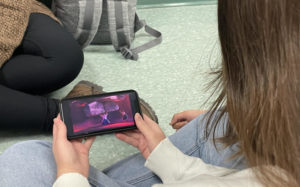Female gaze provides false freedom

Illustration represents how directors attempt to portray the female gaze through media.
March 15, 2023
As new trends arise on social media, the term female gaze has taken over posts and comment sections. It has lost its meaning and become a common adjective. The female gaze is a term referring to the gaze of a female spectator, character or director of an artistic work, in which women are represented as individuals with independence and agency.
The idea of the male and female gaze originated in Laura Mulvey’s feminist theory which states that “women are simultaneously looked at and displayed with their appearance coded for strong visual and erotic impact.” The female gaze is non- existent and has the potential of leading us back into the trap of the male gaze. In order for a female gaze to exist, there would need to be a female dominant culture in which women have the power over how they are treated and seen in society.
However, due to the oppressive power that men hold in this society, women are brought up with an inner voice that is harsh and critical of themselves. The male gaze defines women based on their physical appearance and does not give female characters depth or personality.
For example, some movies that are considered part of the male gaze include “Suicide Squad,” “Transformers,” and the “Wolf of Wall Street.” Directed by men, these movies contain female characters that are objectified and unrealistic. They are not given depth or personality, but are rather tools in the progression of the male characters. Although Harley Quinn’s character in “Suicide Squad” contrasts gender stereotypes by being reckless and wild, her revealing costume and child-like pigtails are designed to cater to the male audience, which takes away from her character development.
To contrast this depiction of Harley Quinn, Cathay Yan directed a movie called “Birds of Prey” which includes a different version of her character in which she reinvents herself after cutting ties with Joker. While this portrayal is more progressive, it doesn’t fall under the female gaze because her development is still centered around a man.
Because the male gaze restricts the complexity of women, the idea of a female gaze has become increasingly popular. Some popular movies that are considered to embody the female gaze are “Clueless” and “Legally Blonde”. In both of these movies, the female lead is characterized as extremely girly and fashionable, while still remaining ambitious and independent.
Elle Woods from “Legally Blonde” managed to receive a 179/180 on her LSAT and attend Harvard Law School while still maintaining her appearance and style. Similarly, Cher Horowitz, who is the female lead in “Clueless,” is an icon for fashion and is characterized as independent throughout the movie; however, the plot and the ending of the movie revolve around a male. While the idea behind these movies is meant to be inspiring for women, they only feed into the unrealistic standard set for women to be perfect.
There have also been a set of movies such as “Gone Girl” and “Girl Interrupted” in which there is a female lead that is driven to her breaking point by a man and is characterized as hysterical and crazy. Categorizing these movies as the female gaze is harmful because it insinuates that the complexity of a woman can only be revealed when she chooses to be free from a man and it romanticizes the rage that these women experience.
A character that does not adhere to a male fantasy is a male fantasy itself. While moving away from the male gaze is necessary, the most productive way to do so would be to acknowledge the existence of a male gaze and focus on personal qualities when creating a character, rather than using a female gaze.



